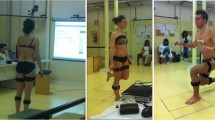Abstract
A new method for the detection of gait cycle phases using only two miniature accelerometers together with a light, portable digital recorder is proposed. Each subject is asked to walk on a walkway at his/her own preferred speed. Gait analysis was performed using an original method of computing the values of temporal parameters from accelerometer signals. First, to validate the accelerometric method, measurements are taken on a group of healthy subjects. No significant differences are observed between the results thus obtained and those from pressure sensors attached under the foot. Then, measurements using only accelerometers are performed on a group of 12 patients with unilateral hip osteo-arthritis. The gait analysis is carried out just before hip arthroplasty and again, three, six and nine months afterwards. A mean decrease of 88% of asymmetry of stance time and especially a mean decrease of 250% of asymmetry of double support time are observed, nine months after the operation. These results confirm the validity of the proposed method for healthy subjects and its efficiency for functional evaluation of gait improvement after arthroplasty.
Similar content being viewed by others
References
Abu-Faraj, Z. O., Harris, G. F., Abler, J. H., andWertsch, J. J. (1997): ‘A Holter-type, microprocessor-based, rehabilitation instrument for acquisition and storage of plantar pressure data’,J. Rehabil. Res. Dev.,34, pp. 187–194
Aminian, K., Robert, P., Jequier, E., andSchutz, Y. (1995): ‘Incline, speed, and distance assessment during unconstrained walking’,Med. Sci. Sports Exerc.,27, pp. 226–234
Aminian, K., Robert, Ph., Jéquier, E, andSchutz, Y. (1995): ‘Estimation of speed and incline of walking using neural network’,IEEE Trans. Inst. Meas.,44, pp. 743–746
Aminian, K., De Andrés, E., Rezakhanlou, K., Fritsch, C., Depairon, M., Schutz, Y., Leyvraz, P. F., andRobert, Ph. (1998): ‘Motion analysis in clinical practice using ambulatory accelerometry, Captech 98, LNAI 1537, Springer-Verlag, pp. 1–11
Anderson, G. (1972): ‘Hip assessment: a comparison of nine different methods’,J. Bone Joint Surg.’,54B, pp. 621–625
Breit, G. A., andWhalen, R. T. (1997): ‘Prediction of human gait parameters from temporal measures of foot-ground contact’,Med. Sci. Sports Exerc.,29, pp. 540–547
Chan, R. B., andChildress, D. S. (1991): ‘Temporal factors of self-selected free-paces walking: relationships to an inverted pendulum method’,Adv. Bioeng.,20, BED, ASME, pp. 525–530
Evans, A. L., Duncan, G., andGilchrist, W. (1991): ‘Recording accelerations in body movements’,Med. Biol. Eng. Comput.,29, pp. 102–104
Ferrigno, G., andPedotti, A. (1985): ‘ELITE: A digital dedicated hardware system for movement analysis via real-time TV signal processing’,IEEE Trans.,BME-32, pp. 943–950
Giannini, S., Catani, F., Bendetti, M. G., andLeardini, A. (1994): ‘Gait analysis: methodologies clinical applications’, IOS Press, Amsterdam
Graupe, D., Grosspietsch, J. K., andBasseas, S. P. (1987): ‘A single-microphone-based self-adaptive filter of noise from speech and its performance evaluation’,J. Rehabil. Res. Dev.,24, pp. 119–126
Hirokawa, S., andMatsumara, K. (1987): ‘Gait analysis using a measuring walkway for temporal and distance factors’,Med. Biol. Eng. Comput.,25, pp. 577–582
Hoyt, R. W., Knapik, J. J., Lanza, J. F., Jones, B. H., andStaab, J. S. (1994): ‘Ambulatory foot contact monitor to estimate metabolic cost of human locomotion’,J. Appl. Physiol.,76, pp. 1818–1822
Liang, M. H., Fosset, A., andLarson, M. (1990): ‘Comparisons of five health status instruments for orthopedic evaluation’,Med. Care,28, pp. 632–642
Lieberman, J. R., Dorey, F., Shekelle, P., Schumaker, L., Thomas, B. J., Kilgus, D. J., andFinerman, G. A. (1996): ‘Differences between patients' and physicians' evaluations of outcome after total hip arthroplasty’,J. Bone Joint Surg.,78A, pp. 835–838
Macellari, V., andGiacomozzi, C. (1996): ‘Multistep pressure platform as a stand-alone system for gait assessment’,Med. Biol. Eng. Comput.,34, pp. 299–304
Maki, B. E. (1997): ‘Gait changes in older adults: predictors of falls or indicators of fear’,J. Am. Geriatr. Soc.,453, pp. 313–320
Rose, J., andGamble, J. (1994): ‘Human walking’ (Williams & Wilkins, Baltimore), p. 29, p. 143
Rosenrot P. (1982): ‘Footswitch stride analyser’,Bull. Prosthet. Res.,18, p. 284
Wall, J. C., Ashburn, A., andKlenerman, L. (1981): ‘Gait analysis in the assessment of functional performance before and after total hip replacement’,J. Biomed. Eng.,3, pp. 121–127
Zhu, H. S., Wertsch, J. J., Harris, G. F., Loftsgaarden, J. D., andPrice, M. B. (1991): ‘Foot pressure distribution during walking and shuffling’,Arch. Phys. Rehabil.,72, pp. 390–397
Author information
Authors and Affiliations
Corresponding author
Rights and permissions
About this article
Cite this article
Aminian, K., Rezakhanlou, K., De Andres, E. et al. Temporal feature estimation during walking using miniature accelerometers: an analysis of gait improvement after hip arthroplasty. Med. Biol. Eng. Comput. 37, 686–691 (1999). https://doi.org/10.1007/BF02513368
Received:
Accepted:
Issue Date:
DOI: https://doi.org/10.1007/BF02513368




